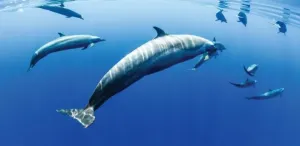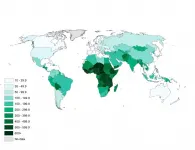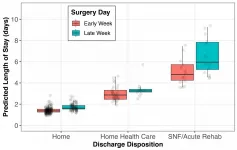(Press-News.org) Humans have altered the ocean soundscape by drowning out natural noises relied upon by many marine animals, from shrimp to sharks.
Sound travels fast and far in water, and sea creatures use sound to communicate, navigate, hunt, hide and mate. Since the industrial revolution, humans have introduced their own underwater cacophony from shipping vessels, seismic surveys searching for oil and gas, sonar mapping of the ocean floor, coastal construction and wind farms. Global warming could further alter the ocean soundscape as the melting Arctic opens up more shipping routes and wind and rainfall patterns change.
Yet noise has been conspicuously absent from global assessments of ocean health.
A team led by Carlos Duarte, distinguished professor at KAUST, trawled more than 10,000 papers and extracted the most rigorous quantitative studies of how noise affects marine animals. "The research goes back nearly 50 years, but this is the first time all the scattered evidence has been assembled and systematically assessed," says Duarte.
Examining the literature, Duarte's team sought to describe ocean soundscapes, how these soundscapes have changed in the Anthropocene, the negative impacts they have on marine animals, and possible solutions. "We were stunned by the contrast between the wealth of evidence and the general neglect of the problem in scientific debates and policymaking," says Duarte.
Of the 538 carefully chosen papers, 90 percent revealed significant impacts of human sounds on marine mammals, while 80 percent identified effects on fish and invertebrates, such as jellyfish. "But there's still a gap in our understanding of the impacts on diving birds and sea turtles," adds Duarte.
Shipping is a widespread problem, disrupting travel, foraging, communication behaviors and the ability of young fish to learn to avoid predators. Particularly concerning was the effect of dampened soundscapes on the hearing of larvae trying to navigate to suitable habitats. "If they miss the call home, they will likely starve to death or be eaten," says Duarte.
Noise pollution has driven many marine animals from their natural territory, although escape is not always possible for species with specific ranges, such as the endangered Maui dolphin. In 2020, when global lockdowns were enforced during the COVID-19 pandemic, noise from shipping fell by 20 percent, and dolphins and sharks were spotted swimming through formerly busy, noisy waterways. "This is promising evidence of an almost immediate response of marine life to a relaxing of acoustic pressures," says Duarte.
The researchers highlight ways to alleviate anthropogenic noise, such as reducing shipping speeds, fitting boats with quieter propellers and using floating wind turbines. "Retrofitting only one-tenth of the noisiest boats with better propellers would have widespread benefits," says Duarte. However, marine ecosystems and noise pollution cross international boundaries, meaning that solutions require binding global agreements for restoring a sustainable ocean economy.
INFORMATION:
The world's first ground-based observations of the bare nucleus of a comet nearing the end of its active life revealed that the nucleus has a diameter of 800 meters and is covered with large grains of phyllosilicate; on Earth large grains of phyllosilicate are commonly available as talcum powder. This discovery provides clues to piece together the history of how this comet evolved into its current burnt-out state.
Comet nuclei are difficult to observe because when they enter the inner Solar System, where they are easy to observe from Earth, they heat up and release gas and dust which ...
April 06, 2020-- A new commentary published online in the Annals of the American Thoracic Society provides an exhaustive examination of published research that discusses whether air pollution may be linked to worse COVID-19 outcomes. The studies that the authors examined look at several potential disease mechanisms, and also at the relationship between pollution, respiratory viruses and health disparities.
In "COVID-19 Pandemic: A Wake-Up Call for Clean Air," Stephen Andrew Mein, MD, Department of Medicine, Beth Israel Deaconess Medical Center, Boston, and colleagues ...
A University of Guam review of published research on the critically endangered Serianthes nelsonii tree has revealed a reason why the population of the trees continues to be endangered despite a long history of funded conservation projects and a national recovery plan implemented 26 years ago. The review article, co-authored by biologists of the Plant Physiology Laboratory of UOG's Western Pacific Tropical Research Center, was published on March 2 in Horticulturae journal (doi:10.3390/horticulturae7030043).
"A main message of our paper is that decision-makers from funding agencies limit conservation success when practitioners ...
A revolutionary technology developed within the END ...
WASHINGTON, April 6, 2021 -- Home brewing enthusiasts and major manufacturers alike experience the same result of the beer-making process: mounds of leftover grain. Once all the flavor has been extracted from barley and other grains, what's left is a protein- and fiber-rich powder that is typically used in cattle feed or put in landfills. Today, scientists report a new way to extract the protein and fiber from brewer's spent grain and use it to create new types of protein sources, biofuels and more.
The researchers will present their results today at the spring meeting of the American Chemical Society (ACS). ACS Spring 2021 is being held online April 5-30. Live sessions will be hosted April 5-16, ...
By 2050 global warming could reduce crop yields by one-third. UC Riverside researchers have identified a gene that could put the genie back in the bottle.
Warmer temperatures signal to plants that summer is coming. Anticipating less water, they flower early then lack the energy to produce more seeds, so crop yields are lower. This is problematic as the world's population is expected to balloon to 10 billion, with much less food to eat.
"We need plants that can endure warmer temperatures, have a longer time to flower and a longer growth period," said UCR botany and plant sciences professor ...
DALLAS, April 6, 2021 -- A tsunami of chronic health conditions as a result of the SARS-CoV-2 pandemic, especially cardiometabolic disease, may produce an enormous wave of death and disability that demands immediate, comprehensive strategies. In addition, COVID-19 has disrupted cardiovascular science and medicine, yet it presents opportunities to transform and create novel approaches that can yield new successes. These are the opinions of two esteemed leaders in cardiovascular disease care, research and strategy, detailed in two new Frame of Reference articles published today in the American Heart Association's flagship journal Circulation.
While COVID-19 has severely impacted everyone's daily lives, its societal ...
The inequality is enormous: Mothers in select African countries are more than 100 times more likely to have had a child die than mothers in high-income countries.
This is what Diego Alburez-Gutierrez (Researcher at the Max Planck Institute for Demographic Research (MPIDR) in Rostock, Germany), Emily Smith-Greenaway (Researcher at the USC Dornsife College of Letters, Arts and Sciences in Los Angeles and Guest Researcher at MPIDR), and co-authors found in their recent paper published in BMJ Global Health.
"We offer the first global estimates of the cumulative number of child deaths experienced by mothers ...
CHARLOTTESVILLE, VA (APRIL 6, 2021). New research by a team from the Cleveland Clinic and the London School of Economics and Political Science (LSE) has determined that surgeries performed late in the workweek, and those culminating in discharge to a specialty care facility, are associated with higher costs and unnecessarily longer stays in the hospital following a common elective spine surgery.
Sebastian Salas-Vega, PhD, and colleagues retrospectively reviewed the data for all adult patients who underwent elective lumbar laminectomy over a nearly three-year period at any Ohio hospital included within ...
Newer is not always better; a study in CMAJ (Canadian Medical Association Journal) led by researchers at the University of Warwick shows that simple fetal heartbeat monitoring is still the best method for determining whether a baby is in distress during delivery and whether cesarean delivery is needed http://www.cmaj.ca/lookup/doi/10.1503/cmaj.202538.
Cesarean delivery is the most common surgical procedure worldwide, performed to expedite birth and avoid neonatal complications.
Listening to the fetal heart rate using a stethoscope -- intermittent auscultation -- has been used for years to assess the fetal state and whether the baby is experiencing distress that might require a cesarean delivery. Other monitoring techniques have become ...







